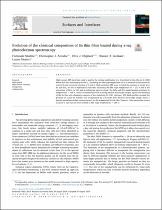| dc.contributor.author | Modiba, F. | |
| dc.contributor.author | Arendse, C.J. | |
| dc.contributor.author | Oliphant, C.J. | |
| dc.contributor.author | Jordaan, W. A. | |
| dc.contributor.author | Mostert, L | |
| dc.date.accessioned | 2022-10-27T13:38:00Z | |
| dc.date.available | 2022-10-27T13:38:00Z | |
| dc.date.issued | 2019 | |
| dc.identifier.citation | https://doi.org/10.1016/j.surfin.2019.100378 | en_US |
| dc.identifier.uri | http://hdl.handle.net/10566/8084 | |
| dc.description.abstract | High-vacuum XPS have been used to analyse the surface modification of a 3 nm-thick Sn thin film on Si (100) before and after annealing up to 450 °C. Increasing the XPS stage temperature led to a reduction in the amount of surface Sn and increasing amounts of O and Si. High-resolution XPS scans revealed the presence of mostly pure Sn and SnO2 for the as-deposited Sn thin film. Increasing the XPS stage temperature to > 232 °C led to the conversion of SnO2 to SnO and an enhancing pure Sn signal. The Si2p and SiO2 peaks become prominent at temperatures > 350 °C, which in combination with scanning electron microscope images, signals the dewetting of the Sn film and subsequent exposure of the underlying Si (100) substrate. XPS depth profiles revealed the presence of a pure Sn metallic core encapsulated by a Sn-oxide shell. Electron microscope images shows a densely packed particulate surface features for the as-deposited Sn thin film. However, these particulate regions increase in size and are more isolated at XPS stage temperatures > 350 °C. | en_US |
| dc.description.sponsorship | National Metrology Institute of South Africa and the National Research Foundation (GUN: 93212, 92520, 103621). | en_US |
| dc.subject | High-vacuum XPS | en_US |
| dc.title | Evolution of the chemical composition of Sn thin films heated during x-ray photoelectron spectroscopy | en_US |
| dc.type | Article | en_US |

